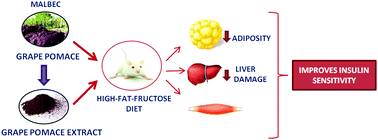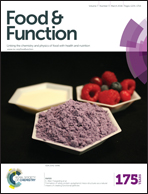Grape pomace and grape pomace extract improve insulin signaling in high-fat-fructose fed rat-induced metabolic syndrome
Abstract
In this study the effect of diet supplementation with grape pomace (GP) and grape pomace extract (GPE) on insulin sensitive tissues (adipose, liver and muscle) was evaluated in an experimental model of metabolic syndrome (MetS). MetS was developed by giving a high-fat-fructose (HFF) diet to Wistar rats. Six weeks of HFF diet induced weight gain, which was partially attenuated by GP (1 g per kg per day) and GPE (300 mg per kg per day) supplementation. HFF diet increased systolic blood pressure, triglycerides, insulin resistance (HOMA:IR) and inflammation (c-reactive protein (CRP)). Supplementation with GP prevented SBP, triglycerides and CRP increased and partially attenuated insulin resistance. On the other hand, GPE partially reduced SBP and triglycerides and significantly prevented insulin resistance and inflammation. Also, HFF diet induced higher triglycerides content and enhanced NADPH oxidase activity in the liver. Also, HFF diet increased the epididymal adipose tissue weight, enlarged adipocyte size, and c-jun N-terminal kinase (JNK) activation, probably contributing to a pro-inflammatory cytokine pattern (higher resistin) and lower adiponectin protein expression. These alterations may result in an impairment of insulin signaling cascade observed in adipose, liver and muscle tissue (IRS1, Akt, and extracellular signal-regulated kinases (ERK1/2)) from HFF rats. Supplementation with GP and to a greater extent GPE attenuated liver triglyceride content and adiposity and restored adipose, liver and muscle response to insulin. These findings show that supplementation with GP and GPE to a greater extent can counteract adiposity, inflammation, liver damage and impaired insulin signaling associated to MetS, supporting the utilization of winemaking residues in food industry/human health due to their high amount of bioactive compounds.


 Please wait while we load your content...
Please wait while we load your content...